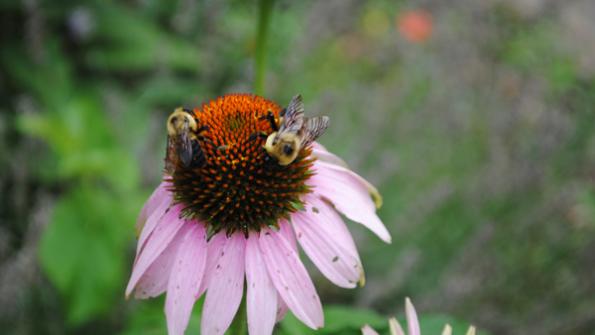March 29, 2013

There are concerns with possible bee kills from the use of neonicotinoid seed treatments when planting corn. The neonicotinoids, when applied to the seed, get mixed with the talc that is used to allow seeds to flow more easily in the planters, and then the insecticides plus talc enter the environment during planting or when the seed boxes are cleaned. This “dust” can settle on flowering plants and weeds that bees will use for forage, or perhaps contact the bees or nearby hives directly resulting in bee mortality.
Although much work and study is ongoing and still needed on the extent of this problem, there are certain practices that growers can use that can help limit bee exposure to these neonicotinoids. The following suggestions are those being recommended by numerous groups and people, including Bayer (the manufacturer of clothianidin or Poncho), and from information received from our neighbors to the north in Ontario, Canada. To see further ideas on limiting bee’s exposure, see Bayer’s Bee Health Care website and read the brochures.
Like what you're reading? Subscribe to CSD Extra and get the latest news right to your inbox!
First, know where beehives are located and remember that bees can forage up to 3 miles from their hive. Communication among growers, seeders and beekeepers on the timing of planting and the location of hives can help reduce the risk of bee incidents. Such communication can enable beekeepers to confirm that hives are located upwind or in shelter belts and have access to clean water sources. It can also permit beekeepers to temporarily protect or relocate hives where this is feasible. The following are suggestions that growers should consider.
During Preplant
1. Avoid generating dust when handling treated seed, pouring seeds carefully into the planter in such a way as to avoid the transfer of dust from the seed bag; do not shake any loose material or dust from the seed bag into the planting equipment.
2. Control flowering weeds before planting so that foraging bees are not attracted to the field during planting.
3. Check that treated seed and coating are of high quality; seeds should be clean and the coating should be well-adhered to the seeds.
4. Handle bags with care during transport, loading and unloading in order to reduce abrasion, dust generation and spillage.
5. Use planting equipment that ensures a high degree of incorporation of seed into the soil and that minimizes spillage and dust emission, and where air exhaust is directed into the ground along with the seed.
6. Because seed flow lubricants may affect the generation of dust during planting; carefully follow use directions.
During Planting
7. Plant in the early morning or in the evening when bees are not foraging.
8. Avoid planting treated seed in windy and/or very dry conditions; consider wind direction and avoiding planting treated seed if bee-attractive flowers are downwind.
9. Make sure seed is placed into the soil and not exposed, especially at row ends and corners.
During Disposal and Cleanup
10. Spilled or exposed seeds and dust should be incorporated into the soil or otherwise cleaned-up from the soil surface.
11. Do not leave empty bags or left-over treated seed in fields or the environment.
12. Do not clean planting equipment near bee colonies, or bee-attractive flowering crops or weeds.
13. Use a broom or shop vacuum to properly dispose of any dust or treated seed in planting equipment, and if compressed air is used, take care to minimize dust release.
14. Properly dispose of any dust or treated seed remaining in planting equipment (for example, empty into a container and vacuum any dust remaining in the hopper).
You might also like:
Drought, Flooding, Warm Weather for Spring
You May Also Like




